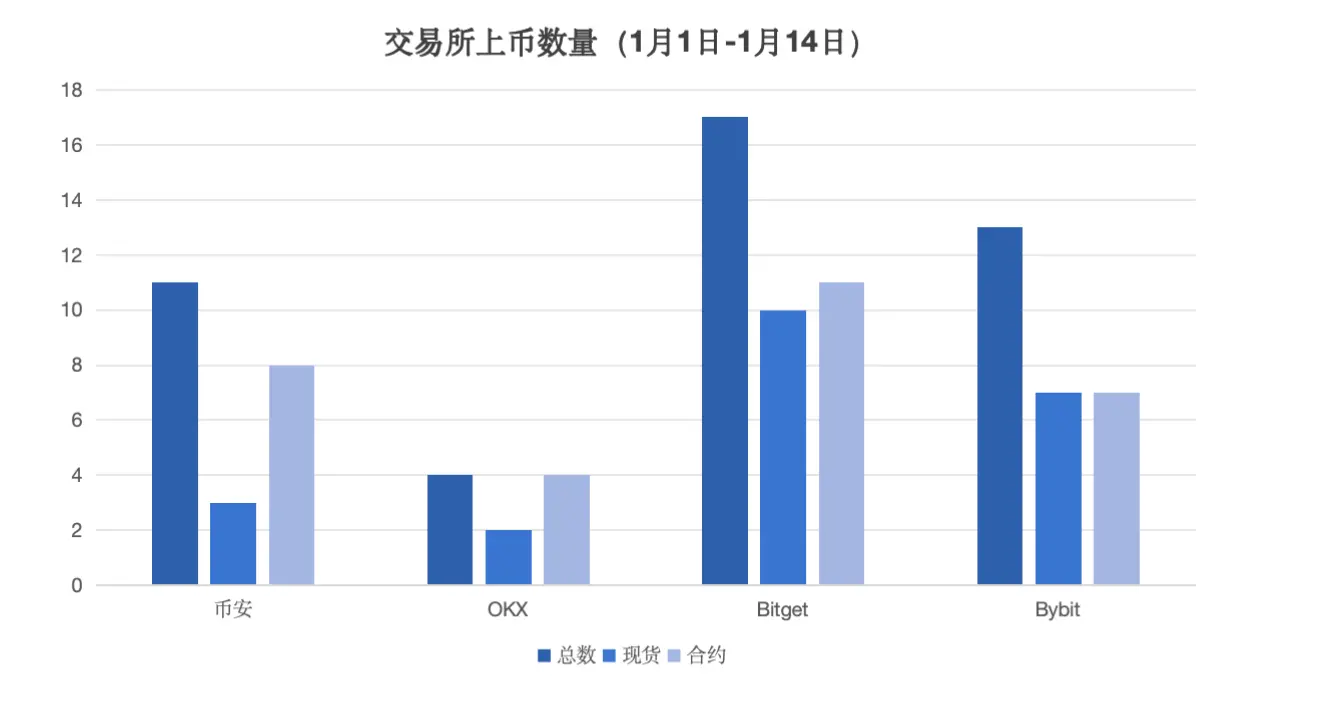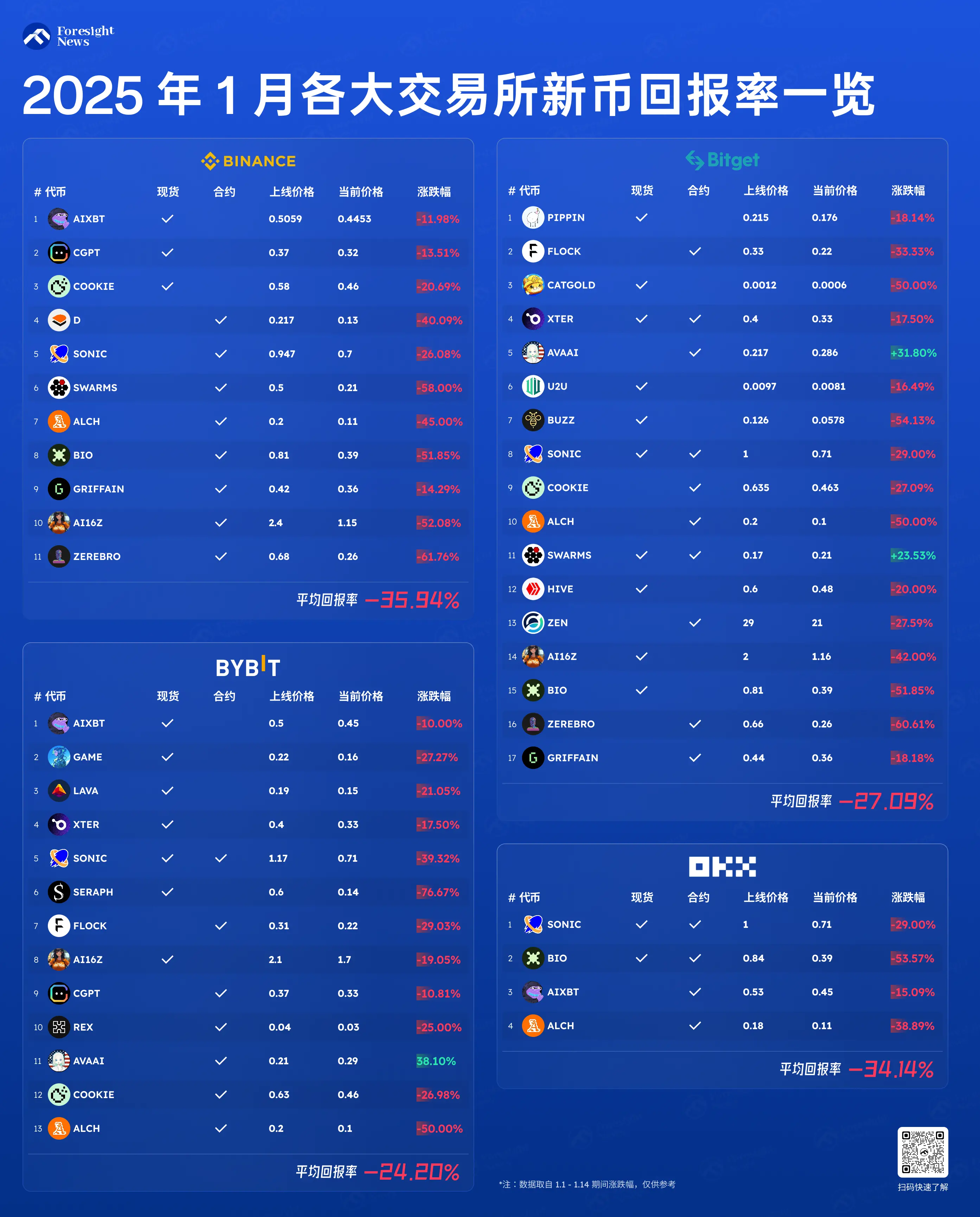“You can go short if you don’t like it”, CEX turns out to be an exit from liquidity

Reprinted from chaincatcher
01/14/2025·23days agoAuthor: Shaofaye123, Foresight News
In 2024, the performance of centralized exchanges was unsatisfactory and was ridiculed as the exit liquidity on the chain. According to a research report released by Animoca Digital Research, the average return rate of major exchanges in the first three quarters was negative.
Entering 2025, the listing of coins on centralized exchanges will still be the tombstone of new coins. Can short selling really achieve permanent profits? This article will give you an overview of the currency listing status of major exchanges in January.

Overview of new releases on each exchange in January

Major exchanges have already started listing coins at the beginning of this year. From the data point of view, OKX’s currency listing strategy is the most conservative, with only 4 tokens listed . Bitget has adopted a more proactive currency listing strategy. So far this year, it has listed 17 tokens and has the highest proportion of listed tokens. Binance and Bybit have 11 and 13 tokens listed respectively, with Binance having the lowest proportion of spot listings.
Performance of new currencies on various exchanges

Since the beginning of the year, the average return rate of exchanges is still negative, with Binance’s average return rate declining the most, down about 10%, to an average return rate of -36%. There is not much difference in the data of other exchanges. Among them, Bitget, with the largest number of coins listed, fell by about -27%.

The above table counts all new tokens (spot and contract) listed on the four major exchanges since January. In order to avoid the phenomenon of pin insertion, the calculated price is the higher of the opening and closing prices of the day. Judging from the above data, all new coins on Binance have negative returns, without exception. Bitget has 2 projects that bucked the trend and rose despite the falling market. Bybit has 1 token that achieved positive returns, and the rest were wiped out. The only four projects listed on OKX also all fell.
In addition, most of the tokens listed in January are still concentrated in AI agent projects. After being repeatedly criticized by the community for only listing VC coins, the number of VC coins listed on Binance dropped sharply in January. Among the 11 tokens listed, 9 are related to AI agents, accounting for 81% . However, because Binance was launched one month later on average than other exchanges , and the fermentation speed on the chain was far behind, the market value had already risen when it was launched, but it ended dismally. AI16Z fell immediately after announcing its listing on Binance, with a drop of more than 10% in 5 minutes. In addition, the market value of projects listed on Binance is relatively high, rarely less than US$100 million , which leads to subsequent weakness in prices and sluggish growth. Looking at the few rising tokens in Bitget, when SWARMS and AVAAI were launched, their market capitalization was less than 100 million US dollars, and the odds of small market capitalization tokens are gradually increasing .
He Yi once said in the community, "You can go short if you don't like it." Now it seems that shorting new tokens on Binance is a good business that is 100% profitable. Not only that, the performance of other exchanges is also very average. If a new coin is shorted on the same day after it goes online, there will rarely even be a retracement. More coins will fall again and again, starting at half the price. It has become a thing of the past to be able to rise by listing on Binance. "Soul pouring" has become the community's impression of Binance's continuous decline.
According to the "2024 CEX Market Report" recently released by 0xScope, among the spot market trends, Binance's market share shrank from 50.9% to 42.5% year-on-year.

The battle for liquidity
Centralized exchanges have long dominated liquidity with their mature infrastructure, strong market depth, and efficient matching mechanisms. But now, with the increasing improvement of on-chain infrastructure, centralized exchanges have gradually become withdrawn from liquidity, and their currency listing effect is constantly weakening. Previously, Pump.fun completed the rapid issuance of Memecoin with its unique pricing curve. Later, on-chain DEXs such as Hyperliquid attracted a lot of attention with the help of large airdrops. The overall market share of centralized exchanges continued to decline. On-chain DEX is eroding the traditional advantages of centralized exchanges at a faster rate.
With the gradual optimization of user experience on the chain and many DeFi innovations, more and more users and funds will migrate to the chain. The high transparency, decentralization and user ownership of funds on the chain ecosystem will further accelerate this transformation. But this does not mean that centralized exchanges will withdraw from the stage. With their advantages of compliant operations and convenient transactions, centralized exchanges will still play an important role in user education, introduction of new assets, and entry of institutional funds.
In the future, the boundaries between CEX and DEX may gradually blur. This liquidity battle will eventually shift from a battle for users and funds to a competition to improve user experience and promote industry development.
The battle for liquidity will bring more innovation and progress, and the crypto industry will eventually win.

 panewslab
panewslab